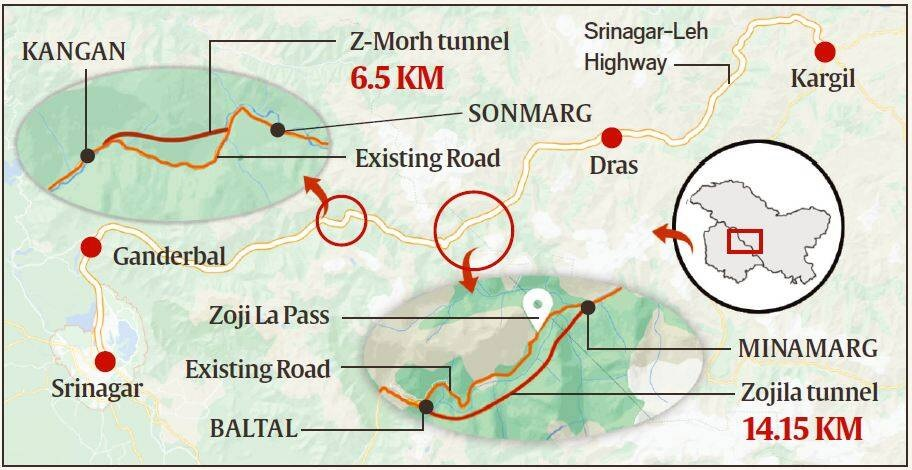Uttarakhand Switch to Hindi
Soapstone Mining in Uttarakhand
Why in News?
- Recently, the Uttarakhand High Court took suo moto cognizance and criticized the authorities for failing to regulate soapstone mining in Bageshwar district of Uttarakhand.
Key Points
- Environmental Concerns:
- Land Subsidence:
- Subsidence is a critical issue in Uttarakhand, exacerbated by mining activities in vulnerable areas like Kanda-Kanyal in Bageshwar.
- Mining operations, soil erosion, removal of resources, and earthquakes contribute to the problem.
- Slope Instability:
- Mining at lower slopes weakens structural integrity, affecting villages on upper slopes.
- Loamy and loose soil increases susceptibility to erosion, particularly during monsoons.
- Deficient Safety Measures:
- Lack of green belts, retaining walls, buffer zones, slope monitoring, and protective structures accelerates erosion.
- Water and Air Pollution:
- Mining activities lead to water scarcity, contamination, and air pollution in the region.
- Land Subsidence:
- Cultural Concerns:
- Impact on Traditional Architecture:
- Land subsidence has damaged Kumaoni Bakhli houses, which historically demonstrated seismic resilience.
- Damage to Heritage:
- Cracks in the Kalika Temple floor in Kanda, a 10th-century site of cultural and religious importance, signify mining-related degradation.
- The region’s cultural practices, including folk music, dance, and handicrafts, are also affected.
- Impact on Traditional Architecture:
- Administrative Lapses:
- The State and Union governments failed to define "semi-mechanised mining," yet granted environmental clearances for such activities.
- Heavy equipment use without clear policy limits has worsened the situation.
Soapstone
- Soapstone is a soft metamorphic rock made of talc with varying amounts of chlorite, dolomite, and magnesite.
- Uses:
- Soapstone is widely used in industries for making sculptures, countertops, sinks, and tiles due to its durability and aesthetic appeal.
- It is used in stoves, fireplaces, and laboratory countertops because of its excellent heat resistance.
- Ground soapstone serves as a filler in paper, cosmetics, and paints.
- It is also used for making utensils, handicrafts, and idols.
- Availability in India:
- As per the Indian Bureau of Mines, Rajasthan (57%) and Uttarakhand (25%) hold significant reserves.
- Rajasthan: The largest producer, particularly in the Udaipur, Dungarpur, and Bhilwara regions.
- Uttarakhand: Notable deposits in Bageshwar, Pithoragarh, and Almora districts.
- Tamil Nadu and Karnataka: Smaller reserves also exist.
- As per the Indian Bureau of Mines, Rajasthan (57%) and Uttarakhand (25%) hold significant reserves.
Chhattisgarh Switch to Hindi
Forest Ecosystem and Green GDP
Why in News?
Recently, Chhattisgarh became the first state in India to link its forest ecosystem to the Green Gross Domestic Product (Green GDP).
- This approach highlights the economic and environmental value of forests, focusing biodiversity conservation and climate change mitigation.
Key Points
- Goals and Design of the Action Plan:
- The plan ensures economic progress while preserving the environment for future generations.
- Key benefits like climate regulation, soil enrichment, water purification, and carbon absorption will now be integrated into the state’s economic planning.
- Importance of Forest Resources in Chhattisgarh:
- With 44% of its land covered by forests, Chhattisgarh’s natural resources are vital to millions.
- Forest products such as tendu leaves, lac, honey, and medicinal plants significantly boost the rural economy.
- Forests absorb carbon dioxide, playing a crucial role in combating climate change.
- Alignment with National Vision:
- The initiative aligns with the Prime Minister’s vision of a "Developed India 2047."
- The plan emphasizes both the economic and environmental benefits of forests in budget planning and policy-making.
- Findings from ISFR Report:
- The India State of Forest Report (ISFR) highlights a significant rise in forest and tree cover in Chhattisgarh, attributed to biodiversity protection and conservation efforts.
- Cultural and Employment Significance:
- Forests in Chhattisgarh hold religious and cultural significance, deeply tied to tribal traditions and spiritual solace for local communities.
- Forests contribute to employment through eco-tourism activities such as jungle safaris and camping in national parks.
- Ecosystem Services Valuation:
- To quantify the economic value of forests, scientists will assess their ecosystem services, including:
- Clean Air:
- Quantifying CO2 absorption by trees and its conversion into oxygen.
- Adding its market value to Green GDP.
- Water Conservation:
- Measuring the economic impact of water provided by forests through rivers and springs.
- Biodiversity:
- Valuing the role of forest fauna in maintaining ecological balance and aiding agriculture.
- Clean Air:
- To quantify the economic value of forests, scientists will assess their ecosystem services, including:
Green Gross Domestic Product (Green GDP)
- Traditional GDP: A measure of the annual value of goods and services produced within a country, GDP has been the global standard since 1944.
- Simon Kuznets, the economist who created GDP, stated that GDP doesn't reflect a nation's true welfare, as it ignores factors like environmental health and social well-being.
- Green GDP: It is a modified version of traditional GDP that accounts for the environmental costs of economic activities.
- It incorporates factors such as natural resource depletion, environmental degradation, and pollution into the economic output, offering a more comprehensive picture of a nation’s true wealth.
- Need for Green GDP: Traditional GDP overlooks sustainability, environmental degradation, and social welfare. It focuses solely on economic output without considering the long-term consequences on the environment.
- Green GDP, on the other hand, ensures that economic growth aligns with sustainable practices, reflecting the true cost of environmental damage and the depletion of natural resources.
- Formula:
- According to the World Bank, Green GDP = NDP (Net Domestic Product) − (Cost of Natural Resource Depletion + Cost of Ecosystem Degradation).
- Where NDP = GDP − Depreciation of Produced Assets.
- Cost of Natural Resource Depletion refers to the value lost due to overuse of natural resources.
- Cost of Ecosystem Degradation refers to the value lost from environmental damage such as pollution and deforestation.
Haryana Switch to Hindi
Haryana to Implement New Criminal Laws
Why in News?
Haryana is going to fully implement the three new criminal laws by 28th February 2025. The widespread adoption of 5G technology would act as a force multiplier, as the new laws require digital evidence through mandatory videography of crime scenes and recovery procedures.
Key Points
- Timelines and Challenges:
- The new laws mandate strict timelines for courts to complete trial proceedings.
- Courts face challenges as they must handle both pending cases under old laws and new cases in a time-bound manner.
- Courts are now required to accept chargesheets electronically, leaving no room for exceptions.
- Amendments to Police Rules:
- The existing Police Rules need amendments to align with the new legal framework.
- For example; introduction of electronic summons delivery, previously unaddressed in the rules.
- E-Summons App:
- The E-Summons App eliminates the need for physical delivery of summons.
- Summons are transferred electronically, served via mobile devices or WhatsApp, and acknowledged screenshots are uploaded to the system.
- Technological Upgrades in Policing:
- Equipment:
- Tablets and mobile handsets are being procured for the police.
- Each police station of Haryana has six computers connected to the Crime and Criminal Tracking Network and Systems (CCTNS).
- E-Sakshya App:
- Designed to upload electronic evidence, requiring extensive backend storage, which is managed by the National Informatics Centre (NIC).
- Equipment:
- Legislative Changes:
- Bharatiya Nyaya Sanhita (BNS), Bharatiya Sakshya Sanhita (BSS), and Bharatiya Nagarik Suraksha Sanhita (BNSS) replaced the Indian Penal Code, Indian Evidence Act, and Code of Criminal Procedure, respectively.
- These laws, effective from 1st July 2024, aim to strengthen infrastructure and forensic capabilities.
National Informatics Centre (NIC)
- It is a premiere S&T institution of the Government of India, established in 1976, for providing e-Government / e- Governance Solutions adopting best practices, integrated services and global solutions in Government Sector.
Crime and Criminal Tracking Network & Systems
- Background:
- Crime and Criminal Tracking Network & Systems (CCTNS) is a plan scheme conceived in the light of experience of a non-plan scheme namely - Common Integrated Police Application (CIPA).
- Launch:
- CCTNS is a Mission Mode Project under the National e-Governance Plan (NeGP) of the Ministry of Home Affairs.
- Approx. 14,000 Police Stations throughout the country have been proposed to be automated besides 6000 higher offices in the police hierarchy.
- It was approved in 2009.
- Objectives:
- Make the Police functioning citizen friendly and more transparent by automating the functioning of Police Stations.
- Improve delivery of citizen-centric services through effective usage of ICT.
- Provide the Investigating Officers of the Civil Police with tools, technology and information to facilitate investigation of crime and detection of criminals.
Jammu & Kashmir Switch to Hindi
PM to Inaugurate Z-Morh Tunnel
Why in News?
The Prime Minister is going to inaugurate the Z-Morh tunnel on 13th January 2025, marking the first major milestone in establishing a year-round strategic corridor between Kashmir and Ladakh.
Key Points
- Strategic Importance of the Z-Morh Tunnel:
- Year-Round Access:
- The Z-Morh tunnel, located in Ganderbal district of central Kashmir, is crucial for keeping Sonamarg open to tourists throughout the year.
- It addresses the previous issue where snowfall and avalanches would block access to the tourist spot in winters.
- Year-Round Access:
- Tunnel Features:
- The Z-Morh tunnel, located under the Thajiwas Glacier, bypasses areas prone to landslides and avalanches.
- An intelligent traffic management system will help regulate vehicle flow and will also facilitate adventure tourism at Thajiwas Glacier and the Sindh River.
- Cultural and Tourism Boost:
- The tunnel was praised as a major infrastructure asset for central Kashmir, with significant potential to boost winter tourism in the region.
- Details of the Tunnel Project:
- Cost and Length:
- The Z-Morh tunnel, built at a cost of Rs 2,680 crore, is 6.5 km long and features a two-lane passage.
- It includes a 10.8-meter main tunnel, a modified horseshoe-shaped escape tunnel, and several culverts.
- Connectivity:
- The Z-Morh tunnel is part of the larger strategic route to Ladakh, linking to the Zojila tunnel.
- The Zojila tunnel, Asia's longest, will reduce travel time between Ganderbal and Kargil from three hours to just 20 minutes.
- Cost and Length:
- Geopolitical and Strategic Significance:
- The Zojila and Z-Morh tunnels are vital for the movement of goods and personnel, especially for security forces stationed in Ladakh.
- The Zojila Pass is currently the only road linking Kashmir to Ladakh but is often closed during the winter months due to heavy snow.
- Both tunnels are located in seismic Zone IV, necessitating the implementation of robust safety measures to prevent structural damage.
Jammu & Kashmir Switch to Hindi
Vande Bharat for Katra-Srinagar Route
Why in News?
Recently, the Railway Board unveiled a Vande Bharat Express train, specially designed to operate seamlessly in the challenging winter conditions of Jammu & Kashmir, for the upcoming Katra-Srinagar rail route.
Key Points
- Climate-Specific Features:
- The Vande Bharat Express, stationed at Shakurbasti coaching depot in New Delhi, has been specially designed for Jammu & Kashmir's extreme winter conditions.
- It features advanced heating systems to prevent the freezing of water and bio-toilet tanks, ensure the vacuum system and laboratories remain warm, and optimize air-brake system functionality in sub-zero temperatures.
- Passenger Amenities:
- The train also includes all amenities found in existing Vande Bharat Express trains, such as fully air-conditioned coaches, automatic plug doors, and mobile charging sockets.
- Symbol of Connectivity:
- The train connects the Kashmir Valley more effectively to the national railway network, symbolizing India's commitment to bridging geographical and economic gaps.
Vande Bharat Trains
- It is an indigenously designed and manufactured semi high speed, self-propelled train that is touted as the next major leap for the Indian Railways in terms of speed and passenger convenience since the introduction of Rajdhani trains.
- The first Vande Bharat was manufactured by the Integral Coach Factory (ICF), Chennai as part of the ‘Make in India’ programme, at a cost of about Rs. 100 crore.
- The Vande Bharat was India’s first attempt at adaptation of the train set technology compared with conventional systems of passenger coaches hauled by separate locomotives.
- The train set configuration, though complex, is faster, easier to maintain, consumes less energy, and has greater flexibility in train operation.
About Indian Railways
- It was established in 1853 and is one of the largest railway networks globally.
- The first train in India ran over a distance of 21 miles, connecting Bombay and Thane.
- India has the 3rd largest metro-rail network in the world after China and the US. By 2050, India is projected to account for 40% of the global rail activity.




%20MPPCS%202025%20Desktop%20E.jpg)
%20MPPCS%202025%20Mobile%20E%20(1).jpg)










.png)
.png)











 PCS Parikshan
PCS Parikshan 2.jpg)
 1.jpg)

 2.jpg)


